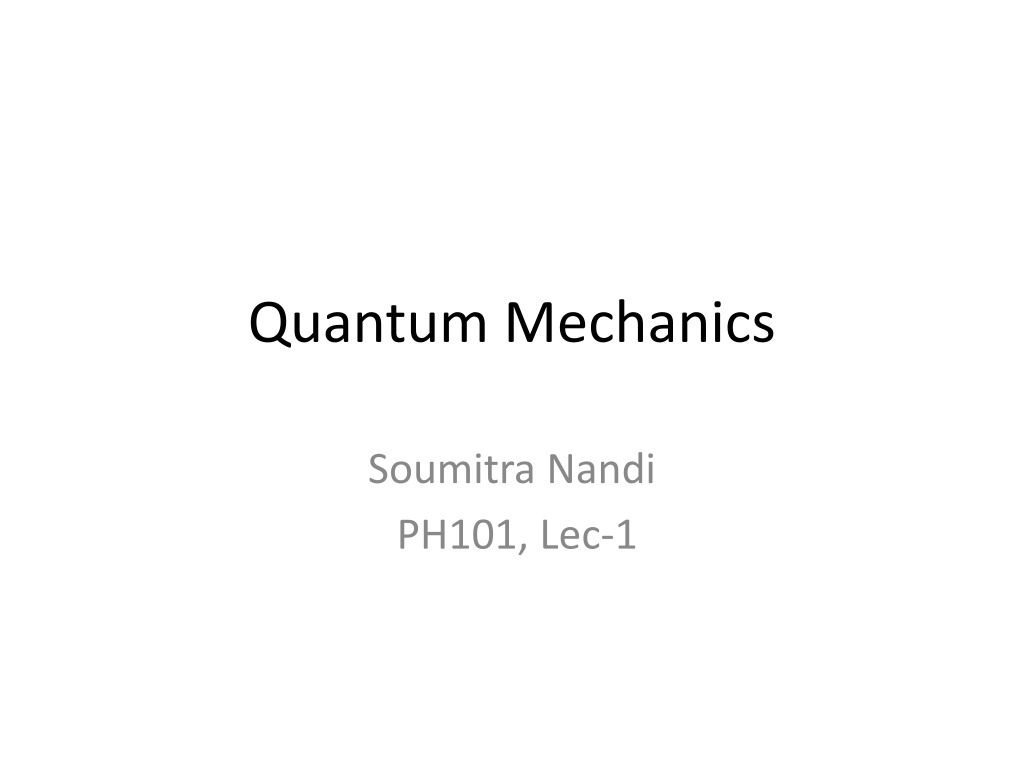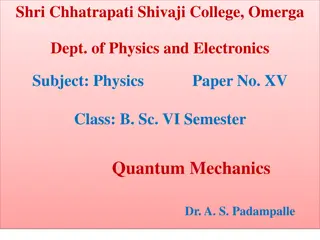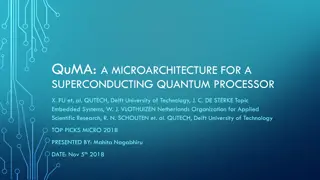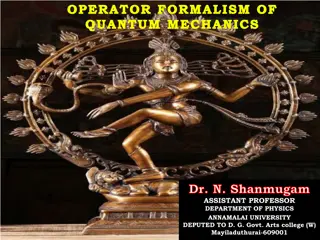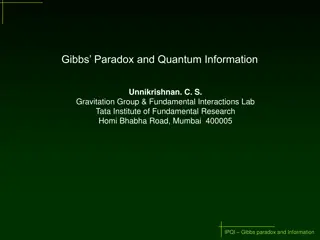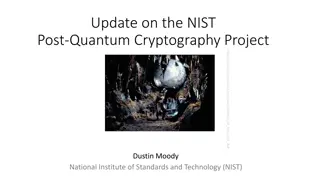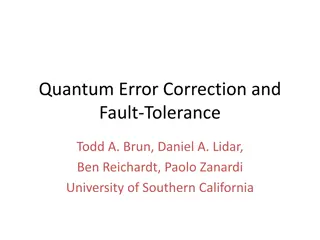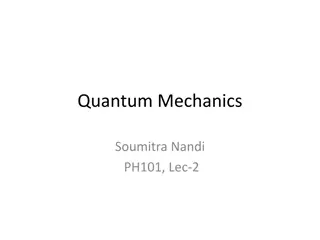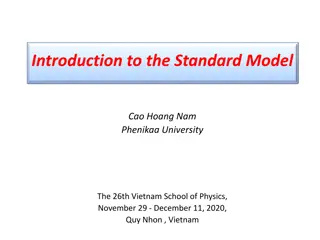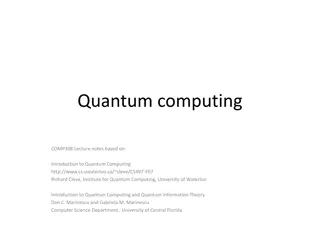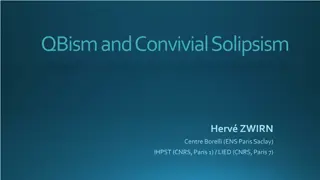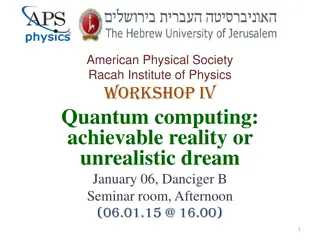Exploring Quantum Mechanics: Unveiling the Mystery of the Subatomic World
Quantum mechanics, the fundamental theory of atomic phenomena, reveals a bizarre yet fascinating world where particles exhibit wave-particle duality and probabilities rule. This theory, beyond direct human perception, explains behaviors in various materials and technologies, paving the way for quantum information, computing, and communication. Contrasting classical mechanics, quantum mechanics challenges our understanding of reality, emphasizing the limitations of deterministic predictions and highlighting the importance of embracing uncertainty.
Download Presentation

Please find below an Image/Link to download the presentation.
The content on the website is provided AS IS for your information and personal use only. It may not be sold, licensed, or shared on other websites without obtaining consent from the author. Download presentation by click this link. If you encounter any issues during the download, it is possible that the publisher has removed the file from their server.
E N D
Presentation Transcript
Quantum Mechanics Soumitra Nandi PH101, Lec-1
Facts At the present stage of human knowledge, quantum mechanics can be regarded as the fundamental theory of atomic phenomena. It is saying something about all physical systems. It is not a physical theory specific to a limited range of physical systems ! Meta-theory The experimental data on which it is based are derived from physical events that almost entirely beyond the range of direct human perception. It is not surprising that the theory embodies physical concepts that are foreign to common daily experience.
Relevance QM can explain the following: Behaviours of insulators, conductors, semi-conductors, and giant magneto- resistance, the radiation of hot body, and its change of colour with respect to temperature, the presence of holes and the transport of holes and electrons in electronic devices .many more Played an Important roles: Photonics, quantum electronics, micro-electronics, nanofabrication techniques, nano optics, quantum optics, micro/nano-electromechanical sensor systems, spintronics Giving rise to New areas Quantum information, Quantum communication, quantum cryptography, and quantum computing. It is seen that the richness of quantum physics will greatly affect the future generation technologies in many aspects. Scientists and engineers should understand quantum mechanics better.
Quantum Weirdness ! The most fascinating aspect of quantum mechanics is that it provides a strange picture of the world. If you accept this picture and given the practical successes of the theory it is difficult not to you are left with no choice but to make fundamental changes to your idea of reality. The first surprise is the wave-particle duality of the building blocks of matter. The world is not made of waves and particles, as in classical physics, but of peculiar hybrid objects with aspects of both. The physical state of a quantum mechanical particle-wave is described by a wave function, (x,t) , analogous to the amplitude of a classical wave. Does not evolve according to the classical wave equation Perhaps the most puzzling aspect of quantum mechanics is that it predicts probabilities only. Its predictive power is such that QM is considered the most successful theoretical physics construct of the human mind.
Classical point of view The state of the particle can be described in terms of its position x and momentum p => take definite real values at any given moment in time. We can calculate and predict to any arbitrary accuracy the position and momentum (x(t), p(t)) of this particle at time t, and at a later time t > t . We can also, in principle, calculate, with unlimited accuracy, the future behaviour of any physical system by solving Newton s equations, Maxwell s equations and so on. Deterministic In practice, there are limits to accuracy of measurement and/or calculation, but in principle there are no such limits. In a system with many particle (a litre of air in a bottle), we cannot hope to measure all the positions and velocities of all the particles. non deterministic Any uncertainty we experience is purely a consequence of our ignorance things only appear random because we do not have enough information to make precise predictions.
Quantum view point The classical world-view works fine at the everyday (macroscopic) level much of modern engineering relies on this ! Non-classical behaviour is most readily observed for microscopic systems atoms and molecules. It is impossible to prepare any physical system in which all its physical attributes are precisely specified at the same time. Irreducible Intrinsic Randomness We cannot pin down both the position and the momentum of a particle at the same time. Microscopic physical systems can behave as if they are doing mutually exclusive things at the same time. Interference : wave nature ! This propensity for quantum system to behave as if they can be two places at once, or more generally in different states at the same time, is termed the superposition of states !!
An example: Two state system The bit is a system that can only has two possible states: 1/0 or up/down or on/off or dead/live etc. We can endow this bit with some set of physical rules which when acted upon the system, may change it from one state to another. Two-state systems A bit is a classical quantity, so we can measure it with arbitrary accuracy => A classical cat can be either dead or alive ! What about a quantum two-state system? What about a Quantum Cat ? The cat is in the curious state of being both alive and dead at the same time according to an observer standing outside ! = l + d
Few basic postulates We do not have knowledge of but still we can still understand few of it s properties !! = l + d Probability amplitudes state vector Postulate 1 (State) : The state of aliveness/deadness of the cat is the linear superposition between two possible states ! Postulate 2 : The probability of measuring an dead/alive state is the absolute square of the inner product of the desired outcome with the state! |?= |?|? Probability of measuring live state = |?.?? |?= |? ?? |?= | |? Probability of measuring dead state = |?.?? |?= |? ?? Postulate 3 (Measurement): Once the box is opened and dead/alive has been obtained, the state vector collapses into the measured state ! ??/?
